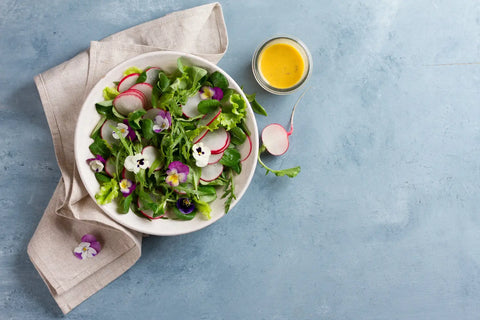There is something so fancy and so fun about eating flowers! Like intricate cake icing or ice cream sprinkles, we all get a rush of delight when we discover that something decorative is also delicious. Whether strewn across salads, tossed in stir fries, preserved in oils or cordials, or candied for dessert decorations, edible flowers elevate any meal and deserve a place in your backyard garden.
People have been eating flowers since the ancient Greeks, Romans, and Egyptians. During the Renaissance, theater-goers snacked on rosewater and stewed primroses. The Victorians were smitten with candied violets. And closer to our headquarters in rural Maine, colonial revolutionaries turned to Bee Balm to make tea after they had tossed the British tea in Boston Harbor.
Edible flowers brighten backyard gardens and like your other crops, can bring nutritious, delicious goodness to your kitchen table. If you want to try introducing edible flowers to your garden or forage them for fun, here are our tips for ten great edible flowers to try and how to prepare them.
Chive Blossoms
Most of us harvest chives before they flower and only prepare dishes with the slender green stems. Don’t toss the blooms when they bolt! The little purple flowers are edible, too. These yummy allium blooms have a different flavor all their own—still onion-esque and sharp but with a subtle floral note that offsets the spice. They can be eaten raw, mixed into fresh butter, sprinkled over a stir fry or eggs, or added to flavored oils to add both beauty and flavor.
Day Lilies
Here in our home state of Maine, day lilies crown high summer with brilliant oranges, golds, and reds along roadsides, fields, and old farm gardens. So some of us were surprised to learn that these decorative dazzlers are also delicious eating raw in salads or in stir fries. While some people believe they are best harvested as buds before the flowers open, they also have a honeyed flavor and crisp crunch in full bloom that makes any salad look and taste spectacular. Their roots are edible, too.
Elderflower
With today’s heightened health concerns, elderberries are in high demand for their immunity-boosting properties in syrups, tinctures, and teas, so it is rare to pick the elderflowers. But it can be done and it is a lot of fun! Elderflower cordial looks like pure sunshine in a glass, particularly when prepared with lemon, and it has antiseptic and anti-inflammatory properties that can help to ease digestion and constipation. We’ve also heard from our customers that elderflowers make a great addition to homemade kombuchas. Your relaxing, after-dinner sip can also shore up your health.
Hibiscus sabdariffa
Don’t let the showy beauty of hibiscus flowers hide their culinary capabilities. As pretty as valentines in shades of red, pink, and blush white, hibiscus flowers have a floral berry flavor (and rich, tantalizing color) that is prized for cooking in cultures around the world. Boiled in water, hibiscus flowers add sweet-start notes to savory fillings in enchiladas, tacos, and quesadillas. And hibiscus tea—or Agua de Jaimaca, as it is known in Mexico—is a completely refreshing beverage served hot or cold that happens to be completely loaded with vitamin C. (Want a shortcut? Pinetree Garden Seeds sells dried organic hibiscus tea or try growing your own from seed.)
Nasturtiums

Of all the edible flowers, nasturtiums are closest to our heart at Pinetree Garden Seeds. Why? Because our founder, Dick Meiners, makes a signature salad that is scattered with nasturtiums and it is one of our favorite tastes of spring and summer. A little bit peppery, kind of like watercress, nasturtiums also work well in spring rolls and lettuce wraps and as a garnish for crudities and dips as well as in salads and stir frys.
Pansies
Making a fruit salad or a summer cocktail? Add a few pansies. Their fresh and mild wintergreen flavor and pretty purple, yellow, and white hues are the perfect enhancements to fresh berries, herbal cocktails, and cheese platters.
Squash Flowers
One of the best tricks our gardening experts know for encouraging big, robust squash growth is to pluck off all but one flower on a squash vine. So what do you do with the rest? Take inspiration from Italian, Mexican, and Filipino cuisine and cook with them. Fried and stuffed with ricotta cheese, squash flowers become savory stars of an Italian feast. They can be fried into fritters, baked into frittatas, tossed into omelettes, and shaved fresh into hearty salads. Squash blossoms are a great way to get the soft, rich taste of squash into a dish without heavy starch.
Roses
Ah, the romance and decadence of dining on roses. Iranian and Persian cuisines incorporate rose petals and rosewater into many dishes as a garnish, as flavoring, and as a dessert-like sweet. (It pairs particularly well with pomegranate seeds and syrups.) Candied rose petals are both dazzling and delicate decorations and rose tea is warming and fragrant. Harvest your roses early in the morning and keep them cool and fresh in damp paper towels before preparing them. The white area at the base of the flower bulb can be bitter, so pull petals further from the stem.
And if you live in a coastal region, like we do here in Maine, beach roses are also edible! Harvested after the first frost when the rose hips are plump, orange-red, and sweetened by the cold, they can be pulped into rosehip jellies and jams that have a subtle savory flavor reminiscent of tomatoes.
Violets
Violets can be prepared much like spinach—eaten raw in salads or stewed in soups. In fact, using violets as a thickening agent for soups was very common in Victorian times. Violets smell so sweet but wilt so quickly, so if you hope to use them in a salad or as a cake decoration they will need to be gathered right before you prepare your dish or candied to be preserved. Candied violets are gorgeous but not all of our gardening experts love their strong floral taste. For the best results, pair candied violets with chocolate!
These nine plants are just the beginning of the wide, wild world of edible flowers. There are so many more edible flowers available at Pinetree Garden Seeds, and so many of them are heirloom, organic, and non-GMO varieties that you can grow and consume with confidence.
Have you experimented with edible flowers in your home gardening or cooking? Let us know if you were dazzled or disappointed by the results in the comments!


Thankyou for your information, and great recipes!
My favorite is calendulas, they last a long time and there are multiple colors and they self sow!😄